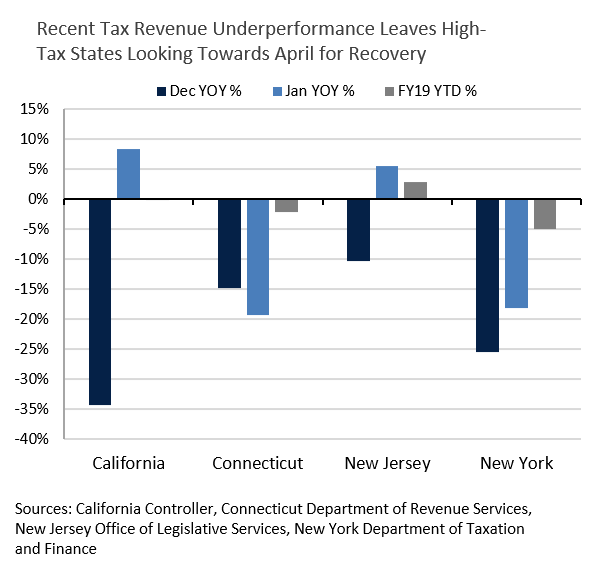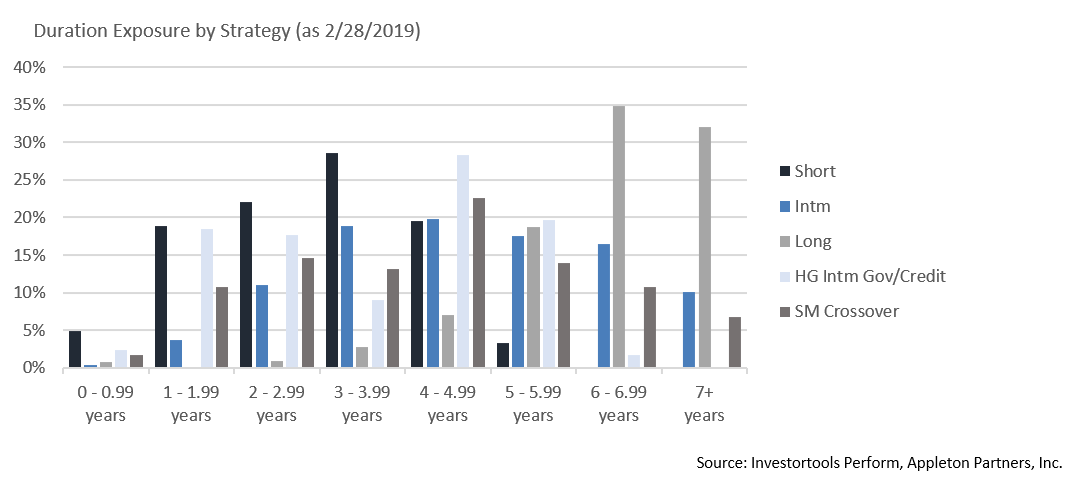Insights and Observations
Economic, Public Policy, and Fed Developments
- President Trump signed a permanent spending bill on February 11th, averting the possibility of a second shutdown, but then declared a national emergency to secure funding for his border wall. A resolution overturning the declaration cleared the House and will likely also pass the Senate, but not by veto-proof majorities. Although this matter may require court intervention to resolve, for now a significant political overhang has been removed from the market.
- Citing significant progress in negotiations, Trump indefinitely extended his March 1st deadline for the re-imposition of tariffs on China. This welcome news came after he previously indicated he would not do so without concessions, including an agreement on intellectual property (IP) protections that is apparently considered a nonstarter by Chinese negotiators. No details were released and the only firm commitments from the Chinese are expanded agricultural and energy purchases and a promise to not devalue the yuan. While administration officials have sounded optimistic, and trade headlines as markets opened on March 4th were favorable, the extension suggests negotiations may not be going especially well. We feel the potential of a deal with significant IP protections and major structural reforms remains low. However, the market will likely greet even a limited deal with relief, as it would take the risk of further tariff increases off the table.
- Q4’s delayed GDP report came in unexpectedly strong, 2.6% vs. Bloomberg consensus of 2.2% and slightly above our anticipated range of 2-2.5%. A slowdown in private inventory investment and government spending were responsible for the widely expected drop from Q3, although this was a good report that further discounts near-term recession risk.
- Chairman Powell’s February Congressional testimony soothed the markets on two fronts. He continued to emphasize that so long as inflation remained muted the Fed can wait and see how economic conditions develop and the markets behave before adjusting interest rates. Powell also repeatedly referred to an average, rather than a maximum, inflation target, thereby opening the door to potentially allowing inflation to exceed 2% for a period. The Chairman’s testimony and January FOMC minutes also indicated that the Fed believes they will complete balance sheet reduction by the end of 2019, with policy guidance coming as soon as March. While the Fed’s balance sheet will remain elevated relative to pre-crisis levels, likely around $3.5-3.6 trillion vs $0.9 trillion, as a % of GDP it has already declined from a high of 25.6% to 19.1% and will likely end 2019 around 16%. A slower pace of Fed asset sales than once anticipated mitigates monetary policy tightening and potentially upward pressure on interest rates.
- While most of the economic picture remains solid, two concerning trends merit close attention. First, an all-time high 7 million Americans are currently 3 months or more behind on car payments. Second, sales of existing homes are continuing to slow, particularly in high tax states. The National Association of Realtors median existing single-family home index and the Case Shiller index dropped by 4% and 4.2%, respectively, while Toll Brothers, a builder of luxury homes, saw a 24% decline in Q4 new orders, with a 62% drop in California. Solid wage gains and recent declines in interest rates should improve affordability, although housing sales are considered an economic leading indicator and unexpected further weakness could foreshadow a greater economic slowdown than the recently experienced slight cooling. This is not our current base case, however.

From the Trading Desk
Municipal Markets
- High grade municipals continue to be elusive in this low supply/high demand environment. While supportive of performance, this tight market presents investment challenges. For the month of February, muni issuance was just $17.99 billion, about 30% behind last year’s numbers. 30-day visible supply is hovering in the $8 billion range, which suggests that issuance going forward will also be limited.
- The demand side of the equation remains strong, perhaps best exemplified by net YTD inflows into municipal mutual funds of more than $12.4 billion, a figure that more than offsets outflows incurred over the second half of last year. High quality names continue to be oversubscribed, resulting in partial allocations, an added challenge to getting cash invested.
- Against this strong technical backdrop, the 10-year Muni/Treasury ratio currently stands at 77%, the lowest level since 2010. Although this may prompt relative value questions, the tax-advantaged income and portfolio stability offered by municipals remains in demand, particularly given a growing recognition of the State and Local Tax (SALT) deduction limitation’s impact in high state taxes. A solid environment for municipal performance persists in our view and, as a frame of reference, the 10-year Muni/Treasury ratio averaged just above 78% for much of the 1990s.
- A seasonal adjustment in SIFMA/VRDN rates is ongoing, impacting tax-exempt short-term investment choices (a subject we wrote about last April, “Optimizing Short-Term Investment Assets”). As we approach tax time, investors often sell cash equivalents to pay tax bills, thereby causing the rates on those instruments to increase. This adjustment is especially notable this year given additional tax burdens resulting from the $10,000 cap on State and Local Tax (SALT) deductions. As we write, the SIFMA Municipal Swap Index is yielding 1.67%. Where SIFMA yields go from here is unknown, although we foresee rate resets at higher levels. Selling pressure is anticipated until these securities attract substantial demand from crossover buyers. Crossover buyers will likely be comparing it to LIBOR, which may ultimately act as a cap on SIFMA reset rates. Nonetheless, in today’s environment VRDNs present an attractive, high quality, tax-efficient option for short-term liquid holdings.

Taxable Markets
- The tone in investment grade credit continues to be strong. After a challenging end to 2018, market appetite for corporate credits has rebounded and compressed spreads to levels not seen since November of 2018. B of A/Merrill Lynch US Corporate Master OAS receded to 129 basis points at the end of February. The Fed’s pivot towards a more dovish tone and a feeling that the year-end credit sell-off was overblown have been key drivers. According to Bloomberg Barclays, US IG credit has returned 2.68% YTD through February and US High Yield returned 6.27% over the same period.
- Investment Grade credit ratings are also strengthening, as the number of Moody’s upgrades has recently far outpaced downgrades. So far this quarter there have been 31 upgrades and only 8 downgrades, a highly favorable 3.88/1 ratio. This compares to a 10-year average is 1.57 and reflects positively on overall credit trends.
Public Sector Watch
Credit Comments
State Tax Revenue Underperformance: Timing or Structural?
- Following large year-over-year declines in December tax revenues among “high tax” states, some officials were hoping for a rebound in January collections. As the accompanying chart reveals, performance in January was better, but still relatively weak, leaving year-to-date fiscal revenues trailing projections in California, Connecticut, New York and New Jersey.
- Some state officials have blamed the Tax Cuts and Jobs Act’s cap on state and local tax (SALT) deductions for revenue shortfalls, arguing that wealthy individuals are leaving high-tax states, many of whom are governed by Democrats. While the SALT cap may be influencing the timing of tax collections, recent data suggests that mass outmigration of affluent taxpayers, a potential far bigger structural problem, is not yet a widespread phenomenon.
- State tax revenues were generally outperforming expectations through November of last year, with declines concentrated in December and January. In our view, timing indicates that a mix of poor Q4 equity performance and lack of incentive to pre-pay state and local taxes due to the SALT cap were the primary culprits.
- Bondholders thus far have not reacted to these sluggish revenue figures. April collections will be critical to determining whether recent tax revenue weakness is a function of timing or larger structural challenges for high-tax states.

COFINA 2.0
- Following approval of the plan of adjustment by federal judge Laura Taylor Swain, Puerto Rico successfully delivered new securities to holders of the Commonwealth’s Sales Tax Financing Corporation, better known as COFINA.
- The exchange marks the second successful restructuring of Puerto Rico debt, with the Government Development Bank exchanging debt with creditors in 2018. Senior lien holders of COFINA debt received securities with an initial value of 93% relative to their par holdings. Subordinated holders walked away with recoveries close to 56%.
- For bondholders who held out, recoveries were much higher than where the COFINA tranches were trading earlier in 2018. However, holders of non-insured COFINA bonds received nearly 30 new CUSIPs with various coupons, maturity and call structure. We note that the rating agencies have not provided a rating on the new structure, and approximately 1.3% of the CUSIPs are insured by Assured Guaranty Municipal.
- Early trading in the securities, based on the largest current interest bond (CUSIP 74529JPX7), reflects pricing between $94 and $98.
- We do not own any Puerto Rico debt issues. Nonetheless, these high-profile restructurings are worth monitoring. Market reaction has been muted, and the announcements did not appear to have any broader credit implications.

Strategy Overview
Portfolio Positioning as of 2/28/2019

Duration Exposure by Strategy as of 2/28/2019

Our Philosophy and Process
- Our objective is to preserve and grow your clients’ capital in a tax efficient manner.
- Dynamic active management and an emphasis on liquidity affords us the flexibility to react to changes in the credit, interest rate and yield curve environments.
- Dissecting the yield curve to target maturity exposure can help us capture value and capitalize on market inefficiencies as rate cycles change.
- Customized separate accounts are structured to meet your clients’ evolving tax, liquidity, risk tolerance and other unique needs.
- Intense credit research is applied within the liquid, high investment grade universe.
- Extensive fundamental, technical and economic analysis is utilized in making investment decisions.




